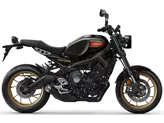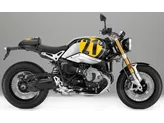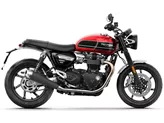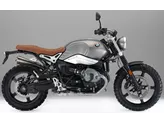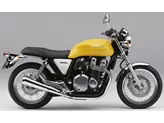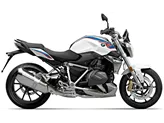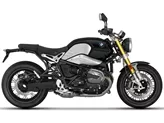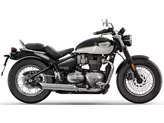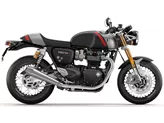Yamaha XSR900 2018 vs. BMW R nineT 2018

Yamaha XSR900 2018

BMW R nineT 2018
Overview - Yamaha XSR900 2018 vs BMW R nineT 2018
The Yamaha XSR900 2018 and the BMW R nineT 2018 are both naked bikes that offer a thrilling riding experience. However, there are several key differences between the two models.
In terms of engine specifications, the Yamaha XSR900 is equipped with an inline, liquid-cooled engine with a displacement of 847cc. It delivers a power output of 115 HP and a torque of 87.5 Nm. On the other hand, the BMW R nineT features a boxer engine with a displacement of 1170cc. It produces a slightly lower power output of 110 HP but offers a higher torque of 116 Nm. Both bikes have a similar number of cylinders, with the Yamaha XSR900 having 3 cylinders and the BMW R nineT having 2 cylinders.
Both bikes feature upside-down telescopic forks for the front suspension and monoshock absorbers for the rear suspension. However, the BMW R nineT has an additional paralever suspension system for the rear, which provides improved stability and comfort. The chassis of the Yamaha XSR900 is made of aluminum and has a twin tube frame, while the BMW R nineT has a steel chassis with a tubular, load-bearing engine frame.

Yamaha XSR900 2018
In terms of braking performance, both bikes are equipped with double disk brakes at the front. The Yamaha XSR900 has a front disk diameter of 298mm, while the BMW R nineT has a larger front disk diameter of 320mm. Both bikes also come with ABS as an advanced rider assistance system.
In terms of dimensions and weights, the Yamaha XSR900 has a slightly shorter wheelbase of 1440mm compared to the BMW R nineT's wheelbase of 1487mm. The seat height of the Yamaha XSR900 is 815mm, while the BMW R nineT has a slightly lower seat height of 803mm. The Yamaha XSR900 has a kerb weight of 191kg with ABS, while the BMW R nineT is heavier with a kerb weight of 222kg with ABS. The fuel tank capacity of the Yamaha XSR900 is 14 liters, while the BMW R nineT has a larger fuel tank capacity of 18 liters.

BMW R nineT 2018
In terms of strengths, the Yamaha XSR900 has an extremely sporty and rev-happy engine, excellent brakes, and a pleasant seating position. It also offers high-quality workmanship and a good price-performance ratio. On the other hand, the BMW R nineT is praised for its characterful boxer engine, powerful low-end torque, comfortable seating position, extensive equipment, and a large accessories market. It also has a cool and unique look.
However, both bikes have their weaknesses. The Yamaha XSR900 has an almost too direct response, and some feel that the retro style could have been thought through to the last detail. The BMW R nineT has concerns regarding the footrest position when maneuvering and passenger ride comfort. Additionally, the BMW R nineT is generally more expensive compared to the Yamaha XSR900.
In conclusion, both the Yamaha XSR900 2018 and the BMW R nineT 2018 are impressive naked bikes with their own unique strengths and weaknesses. The Yamaha XSR900 offers a sporty and agile ride, while the BMW R nineT provides a characterful engine and a comfortable riding experience. Ultimately, the choice between the two will depend on individual preferences and priorities.
Technical Specifications Yamaha XSR900 2018 compared to BMW R nineT 2018
Pros and Cons in comparison
Pros and Cons in comparison
Yamaha XSR900 2018

The Yamaha XSR900 is a classic optical illusion - with its round headlight, angular tank and attached tail light, it clearly passes for a retro bike. But it's no coincidence that the performance is reminiscent of the potent mid-range naked bike Yamaha MT-09, which is the extremely sporty basis for the XSR900. So the engine is a blast and the brakes are appropriately venomous. Fortunately, the engineers didn't overdo it with the chassis, the XSR900 offers sufficient comfort and the upright riding position is more comfortable than the powerful engine would lead one to expect. All in all, the XSR900 is one of the sportiest models among the retro bikes.
BMW R nineT 2018

What more can be said about the BMW R nineT? Since its release in 2014, it has been a real perennial favourite in the customising scene and also at BMW itself. Its ingredients, however, are of very high quality and explain why the result is so coherent. The boxer engine, full of character, is a real joy every time you pull the throttle and, thanks to the wonderful sound, it never gets boring in the long run. Despite the relatively high weight, the BMW is pleasant to ride thanks to the high-quality chassis and finds a balanced mixture between cruiser and sporty naked bike. The look is of course a matter of taste, but the sales figures suggest that BMW must have done something right. And even if you don't like the standard look, accessories are a dime a dozen.
Price Comparison Avarage Market Price Yamaha XSR900 vs BMW R nineT
There are a few key differences between a Yamaha XSR900 2018 and a BMW R nineT 2018. In terms of price, the actual average price of a BMW R nineT 2018 is about 71% higher. A Yamaha XSR900 2018 experiences a loss of 180 USD in one year of ownership. This is offset by a loss of 250 USD for a BMW R nineT 2018. Compared to BMW R nineT 2018 there are less Yamaha XSR900 2018 bikes available on the 1000PS.de Marketplace, specifically 4 compared to 15. It takes less time to sell a BMW R nineT with 115 days compared to 123 days for the Yamaha XSR900. Since model year 2016 1000PS.de editors have written 30 reviews for the Yamaha XSR900 and 57 reviews for the BMW R nineT since model year 2014. The first review for the Yamaha XSR900 was published on 11/25/2015 and now has more than 17,600 views. This compares to more than 17,000 views for the first review on BMW R nineT published on 10/17/2013.


